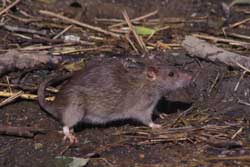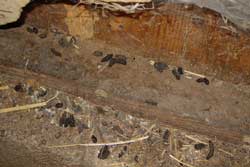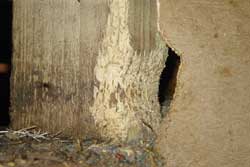Home → Pests → Other Critters → Rats
Rats
Rats are a huge pest problem: they eat and contaminate food, they cause damage to homes and structures, and they transmit diseases to humans and other animals. Rats will make a home anywhere they can access food and cover, including farm buildings, under houses, rubbish dumps and even sewage systems. They climb very well and can fit through a hole as small as 1/2 inch in diameter.
Identification
When controlling for a pest, it is important to ensure you have the correct species in order to make informed decisions based on biology of the species. In Maine, only one species of rat is present, called the Norway Rat. Due to concerns with human health, in most cases wild rat infestations are considered pests.

Norway rats (also called brown or sewer rats) are 13 to 18 inches long, including a 6 to 8 1/2 inch long tail. Their fur is brownish-red.
Click on images to view full-size
Control Information
In many instances, organisms that we deem “pests” may not be pests (some may be beneficial), and other organisms may only be pests in certain instances and control may not always be warranted. In most cases, rats are considered a serious health concern and are considered pests.
Factsheets
- Four Steps to Prevent and Control Rodent Infestations: A Guide for Homeowners and Tenants (PDF)—Maine Board of Pesticides Control/Seattle & King County Public Health
- Integrated Pest Management in the Home and Landscape: Rats (PDF)—University of California
- Integrated Pest Management: Brown Rat Management (PDF)—University of Illinois Extension
- Rodents—Centers for Disease Control and Prevention
- Prevention & Control: Norway Rats (PDF)—Illinois Department of Public Health
- Rat and Mouse Control (PDF)—University of Florida Extension
- Rodent Problem? Protect your Home from Rats and Mice without Harming Wildlife (PDF) - British Columbia Ministry of Environment and Climate Change Strategy
Rats and Rodents in Barns
Rat infestations in barns with horses and other animals can be tricky and must be handled with care. Horses can be poisoned by rodenticide and will get into rat and mouse bait. It is important to get rodent infestations under control, as rat feces can contaminate the feed and cause disease in horses. Some options will be to try out snap traps with pre-baiting, and investigating for runways used by rats and putting out live traps (see articles below). It is also important to find the food source and reduce access. Care is needed when rodenticides are used. Rodenticide baits are very attractive to horses and rats sometimes have the ability to move bait outside of the bait station (or a stubborn horse finding their way into the bait station. Barn cats can also become poisoned by eating the rats.
- Rodent IPM for Your Farm (PDF) - Maine Department of Agricutlure, Conservation & Forestry
- Rodent Control on Farms – UMass Extension
- Rodents around stables and feed stores – Horsetalk.co.nz
- Controlling Rats and Mice around the Farm – University of Florida Extension
- Horse Stable Manure Management (see “rodents”) – PennState Extension
Dig Deeper - Scientific Studies
An assessment of animal welfare impacts in wild Norway rat (Rattus norvegicus) management. - Journal of Animal Welfare, 2022
Summary: Six methods for rat control in the UK were analyzed and ranked to determine the most and least humane. Stakeholders involved in the study included wildlife managers, rodent biologists, animal welfare scientists, and veterinarians. Major conclusions included that the most humane option is prevention, snap traps have the potential to be the most humane method of killing, and when concussive killing is used, controllers should be trained in proper methods to reduce suffering.
More Information
- Dealing with Nuisance Wildlife (PDF)—University of Maryland Cooperative Extension
- Understanding rat biology & behavior—and how to reduce this rodent population in Maine – Interview on Maine Calling, August 2022
Think First, Spray Last - Options for Hired Control
In Maine, the Board of Pesticides Control licenses pesticide applicators in several categories. Rat control falls under category 7A (Structural General Pest Control). To find a licensed applicator in your area, and search for category 7A and your county.

